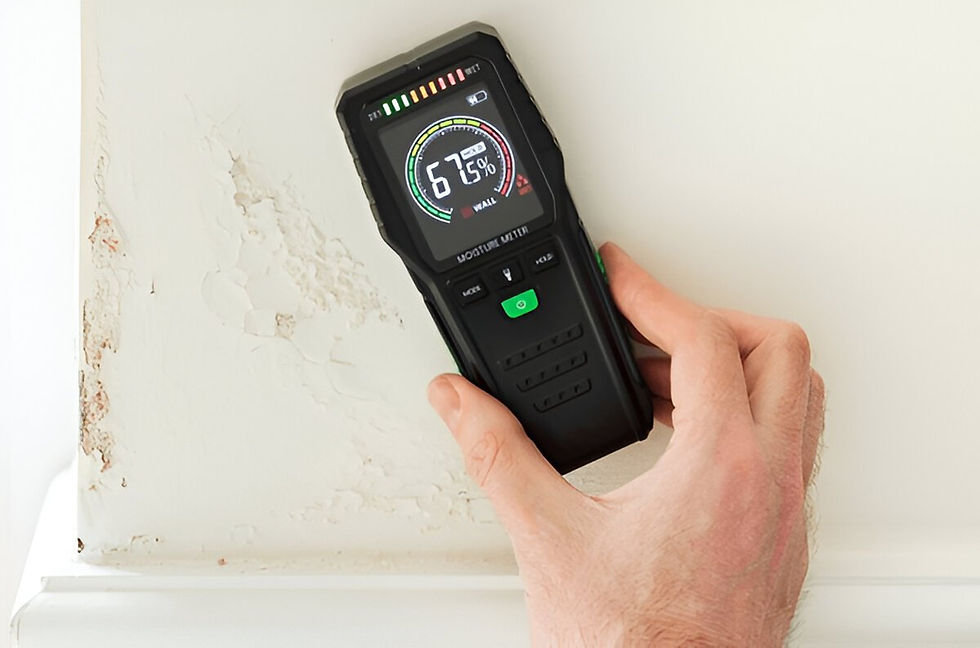The Importance of Moisture Leak Detection in Mold Prevention
- mariotovaropo
- May 24
- 4 min read

Moisture is a silent enemy in many homes, often lurking behind walls, under floors, and in hidden corners. When left unchecked, it can lead to a host of problems, the most concerning being mold growth. Mold not only damages property but also poses serious health risks to occupants. Therefore, understanding the significance of moisture leak detection is crucial for every homeowner. This article delves into the various aspects of moisture leak detection and its vital role in preventing mold infestations.
Understanding Mold and Its Risks
Mold is a type of fungus that thrives in damp environments. It reproduces through spores, which can easily become airborne and spread throughout a home. While some mold varieties are harmless, others, particularly black mold, can be toxic and lead to severe health issues.
Health Implications of Mold Exposure
Exposure to mold can result in various health problems, including:
Respiratory Issues: Mold spores can trigger asthma attacks and other respiratory conditions.
Allergic Reactions: Many individuals are sensitive to mold, experiencing symptoms like sneezing, runny nose, and skin rashes.
Toxic Reactions: Certain molds produce mycotoxins, which can lead to more severe health complications, including neurological issues.
Structural Damage Caused by Mold
Beyond health risks, mold can also compromise the structural integrity of a home. It can weaken walls, ceilings, and floors, leading to costly repairs. Understanding these risks underscores the importance of proactive moisture leak detection.
Common Sources of Moisture in Homes
Identifying potential sources of moisture is the first step in preventing mold growth. Various areas in a home can harbor leaks, leading to damp conditions.
Plumbing Systems
Older plumbing systems are often prone to leaks. Common culprits include:
Pipes: Corroded or damaged pipes can lead to hidden leaks.
Fixtures: Faucets, toilets, and water heaters should be regularly inspected for signs of leakage.
Roof and Gutters
The roof is another critical area to monitor. Issues such as:
Missing Shingles: Can allow water to seep into the home.
Clogged Gutters: Prevent proper drainage, causing water to overflow and penetrate walls.
Windows and Doors
Improperly sealed windows and doors can let moisture in. Regular checks for:
Damaged Seals: Ensure that water cannot enter.
Condensation: Between panes can indicate a problem.
The Role of Moisture Leak Detection
Moisture leak detection is essential for maintaining a healthy living environment. By identifying leaks early, homeowners can prevent the conditions that lead to mold growth.
Early Detection Benefits
Detecting leaks promptly can save homeowners from:
Health Risks: Reducing exposure to mold and its associated health issues.
Financial Burdens: Preventing extensive damage that requires costly repairs.
Technologies for Leak Detection
Modern technology has revolutionized moisture leak detection. Various tools and systems are available to help homeowners identify leaks before they escalate.
Moisture Sensors: These devices can detect hidden dampness and alert homeowners to potential issues.
Smart Home Systems: Integrating leak detection into smart home technology allows for real-time monitoring and alerts.
Implementing Regular Inspections
Routine inspections are a proactive approach to moisture leak detection. By regularly evaluating key areas of the home, homeowners can catch potential problems early.
Key Areas to Inspect
Homeowners should focus on the following areas during inspections:
Basements and Crawl Spaces: These areas are often prone to moisture accumulation.
Roof and Gutters: Regularly check for blockages or damage.
Plumbing Fixtures: Look for any signs of leaks or drips.
Frequency of Inspections
It is advisable to conduct inspections at least twice a year. Seasonal checks, especially after heavy rainfall or snowmelt, can help identify moisture issues before they become serious.
Professional Assistance for Leak Detection
While homeowners can perform routine inspections, engaging professionals for detailed assessments can provide an added layer of protection. Experts can utilize advanced tools and techniques to identify hidden moisture issues that may go unnoticed.
Benefits of Professional Inspections
Thorough Assessments: Professionals can conduct comprehensive evaluations of the property.
Expert Recommendations: They can provide tailored solutions to address specific moisture issues.
Preventive Measures Against Mold Growth
In addition to moisture leak detection, homeowners can take several preventive measures to minimize the risk of mold growth.
Proper Ventilation
Ensuring adequate ventilation in areas prone to moisture, such as bathrooms and kitchens, can help reduce humidity levels. Installing exhaust fans and opening windows can promote airflow and prevent damp conditions.
Humidity Control
Maintaining indoor humidity levels between 30% and 50% is ideal for preventing mold growth. Using dehumidifiers in damp areas can help achieve this balance.
Regular Maintenance
Routine maintenance of plumbing systems, roofs, and gutters is essential for preventing leaks. Homeowners should schedule regular check-ups and repairs to ensure their homes remain leak-free.
Understanding the Cost of Mold Remediation
If mold does take hold, the costs associated with remediation can be significant. Understanding these costs can motivate homeowners to prioritize moisture leak detection.
Factors Influencing Remediation Costs
Extent of Infestation: Larger infestations require more extensive remediation efforts.
Location of Mold: Mold in hard-to-reach areas may increase labor costs.
Type of Mold: Some molds require specialized removal techniques, adding to costs.
Preventing Remediation Expenses
By investing in moisture leak detection and preventive measures, homeowners can avoid the high costs associated with mold remediation.
Conclusion
Moisture leak detection is a critical component of mold prevention. By understanding the risks associated with mold, identifying potential sources of moisture, and implementing proactive measures, homeowners can protect their health and property. Regular inspections, the use of modern technology, and professional assistance can significantly reduce the likelihood of mold growth, ensuring a safe and healthy living environment. Prioritizing moisture leak detection is not just a smart choice; it is an essential step in maintaining a home that is both safe and comfortable.
For more information about Moisture leak detection in Edison New Jersey please contact:
Business Name: Green Guard Mold Remediation of Edison
Address: 6 Kilmer Rd, Edison, NJ 08817, United States
Phone Number: 908-762-8046
Google Map: https://maps.app.goo.gl/nbfnjCYWhWWbWUDA9




Comments